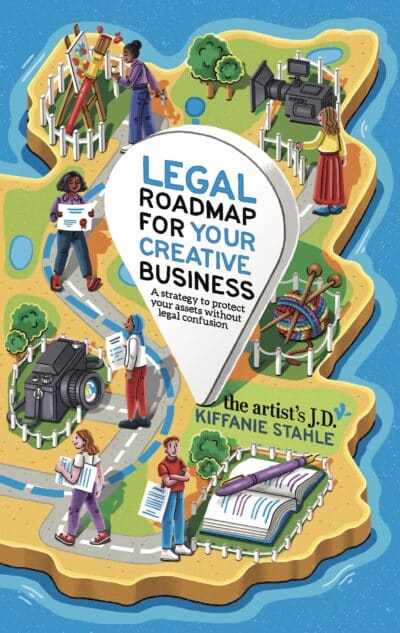Have you wondered whether a proposal or a contract is the right fit for your next creative project?
The terms might seem interchangeable at first, but there are important differences between the two—and knowing when to use each one can make a huge difference in how your business runs smoothly.
Today, I will help you understand the nuances between the two. (And help you avoid the Google conflicting advice timesuck.)
In this post, we’ll dive into:
- the differences between a proposal and a contract
- the strengths of each
- key differences
- which one is right for your project’s needs
So, if you’re a creative who sends client documents and sometimes wonders if you’re fully protected, this guide is for you.
Ready to finally understand which one is best for your creative business? Let’s get started!
Rather watch?
Psst. rather watch the short version? Then hit play below!
- Grab my book that helps you complete enough legal tasks to confidently launch (or grow) your business, knowing you have all your legal ducks in a row. (And the book includes a simple contract template!)
- Do you need to send a “formal” written contract? Watch why my answer is “nope!” here
- Join us in the artist’s Courtyard and get instant access to the “How to write a contract” course (or if you just want a client contract template, you can grab it here).
Does your business have a simple contract?

Inside my book, I include a simple contract template that you can use with those you work with. I also break down why legalese isn’t a requirement for a valid contract. The book also gives you a straightforward strategy to protect your ass(ets) without legal confusion. It’s the go-to guide you need to get all your legal ducks in a row.
(If you use the above Amazon affiliate link, I’ll make a small commission, but it doesn’t change the price you pay.)
Proposal vs. contract: What’s the difference?
A contract and a proposal have two completely different purposes. And because these different purposes explain the differences between the two.
Understanding the purpose of what you’re sending and what stage you’re at in the relationship is the secret to knowing which one you’re going to send.
The purpose of a proposal
A proposal is there to start the conversation with a potential client.
It’s there to tell your client,
This is how I can solve your problem.
Think of a proposal as the “let’s talk about what we want to do” document. It’s an invitation to a conversation. It’s there to deepen the relationship because it’s primarily a sales tool.
Proposals usually include:
- summary of your offer
- deliverables and timeline
- pricing and payment options
- optional upgrades or add-ons
- a way for the client to accept (checkbox or signature)
Yes, your proposal might have some options. You could explain the high-touch service and the budget service.
In addition to having different price points, you might include a general workflow about how you see the project progressing.
But ultimately, the goal of a proposal is to get your potential client to say,
Yes, let’s work together.
Your proposal isn’t there to dive into the nitty-gritty about exactly what it looks like to work together. It isn’t there to explain how you can solve any problems that crop up.
Your proposal is there to open the door to having additional conversations about what it looks like to work together.
The purpose of a contract
A contract has a completely different purpose.
A contract is a relationship-building tool.
A contract is there to document all of your conversations.
It’s designed to get everyone on the same page by literally getting everyone on the same page.
I like to say that a contract is there to make sure that you’re not unintentionally disappointing your clients.
We’ve all worked with clients who have completely unreasonable expectations about what you’re going to do for the cost.
And a contract assures that you and your client have similar understandings.
Contracts usually include:
- everything in a proposal
- roles and responsibilities
- nitty-gritty of the process of working together
- cancellations, late payments, other policies
- ownership and usage rights
- dispute resolution clauses
That’s the purpose of your contract: to make sure everyone is on the same page about what the relationship is going to look like from a nitty-gritty standpoint.
While both are essential, they serve different purposes in the process.
A proposal is a 10,000-foot view, your contract has all of the trees in it.
The strengths of each
Proposals are great for:
- Initial meetings: When you’re just starting a conversation with a potential client, a proposal helps you present your ideas, show them your services, and set expectations. It can be the first step toward securing a project.
- Project is not defined: If the client isn’t 100% sure of their needs or budget, a proposal is a way to outline different options and pricing.
- Project scope definition: If the project is big or has room for negotiation (like a branding package or website design), a proposal is a way to outline the scope and get agreement before moving forward.
Contracts are great when:
- The project is confirmed: Once you and your client agree on the proposal and are ready to start, you’ll want to formalize everything with a contract. This makes everything clear and legally binding.
- You need protection: As I’ve said many times, contracts are there to make sure you don’t unintentionally dissapoint your client. They are there to get everyone on the same page by literally getting everyone on the same page about important things like payments, deadlines, and scope. They also help pre-determine outcomes when common situations arise such as project cancellations, change in scope, and late payments.
Key differences
- Commitment Level: A proposal is like an invitation. It outlines what you’re planning to do, but you don’t have to show up to the event. A contract, on the other hand, is the official “sign on the dotted line” that locks everything in and makes it legally enforceable.
- Flexibility: Proposals are more flexible, allowing changes as you continue the conversation with your client. Contracts are set in stone once signed, so changes require more effort (and may need to be agreed upon in writing).
- Risk Management: While proposals set the stage for expectations, contracts offer solid protection. They cover everything in detail, reducing the risk of misunderstandings, scope creep, and payment issues.
Which one is right for this situation?
Now that we’ve laid out the differences, let’s talk about which one is right for you.
- Use proposals when: You’re still in the negotiation phase or need to outline what a project will look like before getting into the legal stuff. A proposal is ideal for pitching ideas, setting expectations, and presenting your scope of work.
- Use contracts when: You’re ready to get official and start the project. Once your client agrees to the terms you’ve laid out in the proposal, you’ll want to move forward with a contract. This is your protection for payment terms, timelines, and any legal issues that may arise.
When you might combine your proposal and contract
What are the limited circumstances where you might combine them?

The most common reason is situations like Frank the Freelancer.
Frank creates memorable first impressions online by doing brand and website design.
Frank only offers one package.
On his website, he describes his package. Frank’s package is that he designs a single website at a time and does the entire project, start to finish, in four weeks.
This means his services page kind of functions as a proposal. Because it explains:
- what his package includes
- how he works
- what the process looks like
And on his services page, you can click the “Contact Me” button to tell Frank you are interested.
At that point, he schedules a 15-minute phone call with you to make sure that it’s a good fit and that you’ll enjoy working together. (And for Frank to make sure, you are at a point where you are ready for this kind of package.)
If you both agree, then Frank follows the call up with his combined “proposal and contract.”
This format works really well if you:
- only have a single offering
- “preclear” potential clients before sending the document over
My process to send proposals vs. contracts
Most of us aren’t like Frank.
We’re going to send a proposal that outlines how the relationship will work.
Then we’ll ask our potential client to let us know if it sounds good.
And if they agree, send over the contract.
This proposal doesn’t have to be long and detailed.
In fact, for my law firm, they usually are just an email that bullets potential projects and the costs associated with each.
You don’t have to do something long and complicated.
You only need to convey important information and keep the conversation going.
Once you’ve gotten on the same page about how you’re going to help your client and get them to their end goal, then you’ll send a contract.
And the contract will cover the nitty-gritty of what it looks like to work together.
Say goodbye to second-guessing your contract.

Shield Your Studio is a summer workshop series that helps creative business owners write enforceable, respectful client contracts, without burnout, legalese, or rewriting things every time a new client signs on.
By the end of the summer, you’ll have more than a stronger contract. You’ll know how to hold boundaries without guilt, explain your terms with confidence, and stop second-guessing whether your contract can back you up. New sessions will be released throughout the summer, with live Q&As and contract language included.
Imagine sending your contract without overexplaining, apologizing, or adjusting it every time.
Quick takeaways:
- Proposal: A helpful tool to get buy-in and set expectations before you start. It’s informal, flexible, and used early on.
- Contract: Your tool to lock in all the important details and protect both you and your client. It comes after the proposal is accepted and should be signed before you dive into the work.
Remember, both documents play important roles in your business. A well-written proposal is a great way to get clients excited about your work, while a solid contract ensures that everyone is on the same page before the project begins.
How are you going to create your contract?
- a 4600+ word article that breaks down 17 sections that you might want to consider including in your contract
- a course, available exclusively in the artist’s Courtyard, designed to help you step-by-step create your contract and includes multiple contract templates (including a freelance and coaching contract!)
- a client contract template, want to cut right to the template? Then grab a copy of my client contract template that protects you (and those you work with) and includes information on how to customize the template for your business
- Grab my book that includes a simple contract template and helps you complete enough legal tasks to confidently launch (or grow) your business
Does your business have a simple contract?

Inside my book, I include a simple contract template that you can use with those you work with. I also break down why legalese isn’t a requirement for a valid contract. The book also gives you a straightforward strategy to protect your ass(ets) without legal confusion. It’s the go-to guide you need to get all your legal ducks in a row.
(If you use the above Amazon affiliate link, I’ll make a small commission, but it doesn’t change the price you pay.)

Hi! I’m Kiff! I’m your friendly legal eagle (and licensed attorney).
My goal is to add ease to the legalese. And because I think basic legal resources should be available to every creative, I create a lot of free content.
If I’ve created something that has helped inject a little ease into your creative business and you would like to say “thank you”, you can make a contribution here.
If you’d like to hear more from me, I’d love to pop into your inbox every Friday morning to share additional ways to cut through the red tape and inject a little ease.
Get tips from your friendly legal eagle in your inbox…
Your privacy is important to us. Learn how we protect it here.

